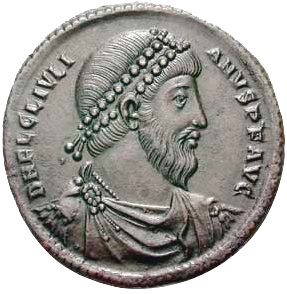 Julian the Apostate, Julian the Heretic, or Julian the Philosopher. (361-363). A pagan emperor of Rome at a time when all the emperors were Christian. With a realization, that Christianity was tearing the empire apart at its roots. He sought to take the empire back to its greatness and unity that it pagan roots had solidified. In his quest, he granted moneys for the expense of the rebuilding of the once proud Temple in Jerusalem.
Julian the Apostate, Julian the Heretic, or Julian the Philosopher. (361-363). A pagan emperor of Rome at a time when all the emperors were Christian. With a realization, that Christianity was tearing the empire apart at its roots. He sought to take the empire back to its greatness and unity that it pagan roots had solidified. In his quest, he granted moneys for the expense of the rebuilding of the once proud Temple in Jerusalem.
Whether the tail is true or was invented to cover the embezzlement of funds cannot be determined without an archeological dig on the temple mount. At the time the tail was believed as true.
3. To the same hostile design against Christianity is to be referred the favor of Julian to its old hereditary enemy, Judaism.
The emperor, in an official document, affected reverence for that ancient popular religion, and sympathy with its adherents praised their firmness under misfortune and condemned their oppressors. He exempted the Jews from burdensome taxation and encouraged them even to return to the holy land and to rebuild the temple on Moriah in its original splendor. He appropriated considerable sums to this object from the public treasury, intrusted his accomplished minister Alypius with the supervision of the building, and promised if he should return victorious from the Persian war, to honor with his own presence the solemnities of reconsecration and the restoration of the Mosaic sacrificial worship.80
His real purpose in this undertaking was certainly not to advance the Jewish religion; for in his work against the Christians he speaks with great contempt of the Old Testament, and ranks Moses and Solomon far below the pagan lawgivers and philosophers. His object in the rebuilding of the temple was rather, in the first place, to enhance the splendor of his reign, and thus gratify his personal vanity; and then most probably to put to shame the prophecy of Jesus respecting the destruction of the temple (which, however, was actually fulfilled three hundred years before once for all), to deprive the Christians of their most popular argument against the Jews, and to break the power of the new religion in Jerusalem.81
The Jews now poured from east and west into the holy city of their fathers, which from the time of Hadrian they had been forbidden to visit, and entered with fanatical zeal upon the great national religious work, in hope of the speedy irruption of the Messianic reign and the fulfillment of all the prophecies. Women, we are told, brought their costly ornaments, turned them into silver shovels and spades, and carried even the earth and stones of the holy spot in their silken aprons. But the united power of a heathen emperor and a Jewish nation was insufficient to restore a work which had been overthrown by the judgment of God. Repeated attempts at the building were utterly frustrated, as even a contemporary heathen historian of conceded credibility relates, by fiery eruptions from on subterranean vaults;82 and, perhaps, as Christian writers add, by a violent whirlwind, lightning, earthquake, and miraculous signs, especially a luminous cross, in the heavens,83 so that the workmen either perished in the flames, or fled from the devoted spot in terror and despair. Thus, instead of depriving the Christians of support of their faith, Julian only furnished them a new argument in the ruins of this fruitless labor.
HISTORY OF THE CHRISTIAN CHURCH by Philip Schaff VOL. 3
